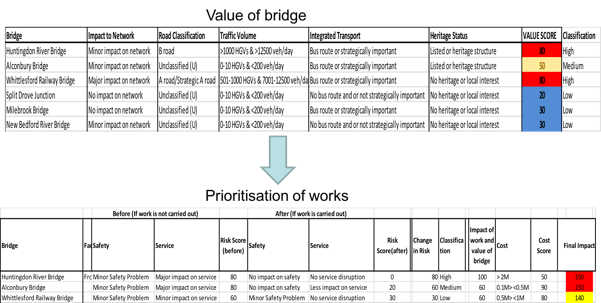Case study: Bridge Maintenance Prioritisation
Background
Cambridgeshire county council is responsible for the maintenance of over 1500 bridges of various types, ages, and usage patterns across the county. The bridges include some with heritage Railway tunnels are the 15th century St Ives River bridge and others of strategic importance with a very high traffic volume.
Project objectives
The council has to determine the annual maintenance tasks required across the bridge portfolio while working with pressing budget constraints; prioritising maintenance activities and justifying expenditure to funders is key. The objective of this case study - working closely with maintenance engineers and planners at the council - was to develop a bridge maintenance prioritisation tool to order annual maintenance activities considering:
- the value generated by the task,
- the cost of maintenance
- the risks posed by the condition of the bridge to the safety and functionality of the bridge.
- factors including heritage status and wider impact on the road network incorporating the needs of all stakeholders.
Approach
The tool complement the three-phase value-based decision-making approach:
- develops a valuation scheme for bridges based on criticality to the network operation
- develops a value-map for the bridge that identifies how the condition of the bridge affects the various value drivers
- uses the value-map and the valuation scheme to quantify the effect of maintenance activities and prioritise activities on the basis of value-for-money

As the Excel-based tool uses a simple scoring scheme, it is practical and easy to understand and implement.
Benefits
CSIC’s bridge maintenance prioritisation tool enabled the council to make better-informed decisions:
- helped bridge managers at the council to justify the annual expenditure on bridge maintenance and to clearly prioritise maintenance activities to ensure maximum value for money spent
- the prioritisation tool could be adapted for use by other councils and bridge owners potentially generating a wide-scale impact
- engagement with asset managers at the council led to a wider appreciation of the value-based approach to asset management, potentially paving way for establishing a step-change in the way assets are managed across the council’s wider asset portfolio









